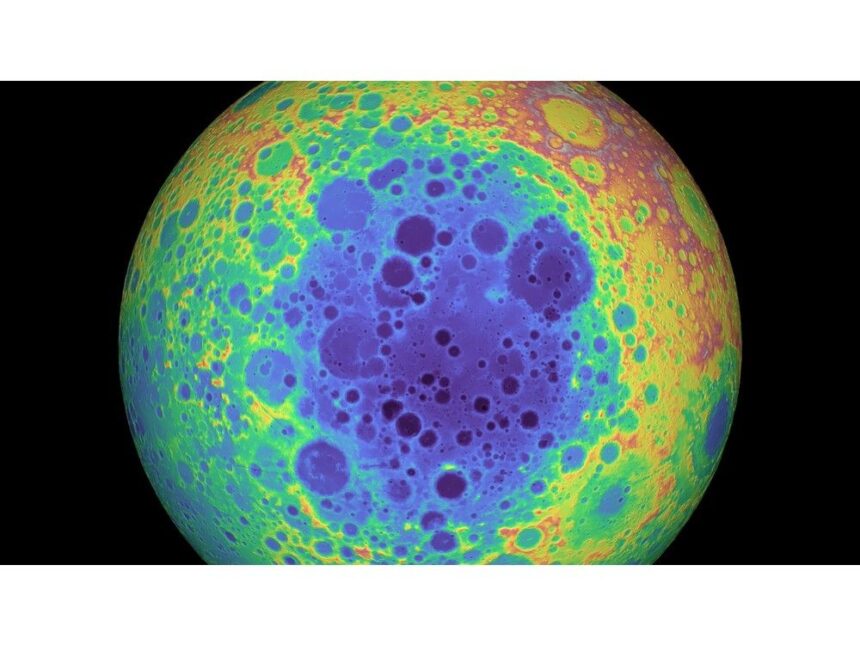Did you know that the moon is prone to ‘moonquakes,’ like our earthquakes?Published Nov 26, 2025Last updated 1 hour ago5 minute readThe South Pole-Aitken Basin on the lunar far side is one of the largest and oldest impact features in the solar system. It’s easily seen in the elevation data. The low center is dark blue and purple. Mountains on its edge, remnants of outer rings, are red and yellow. NASAArticle contentThe moon is most often envisioned as a cold, barren, static world orbiting our vibrant planet.THIS CONTENT IS RESERVED FOR SUBSCRIBERS ONLY.Subscribe now to access this story and more:Unlimited access to the website and appExclusive access to premium content, newsletters and podcastsFull access to the e-Edition app, an electronic replica of the print edition that you can share, download and comment onEnjoy insights and behind-the-scenes analysis from our award-winning journalistsSupport local journalists and the next generation of journalistsSUBSCRIBE TO UNLOCK MORE ARTICLES.Subscribe or sign in to your account to continue your reading experience.Unlimited access to the website and appExclusive access to premium content, newsletters and podcastsFull access to the e-Edition app, an electronic replica of the print edition that you can share, download and comment onEnjoy insights and behind-the-scenes analysis from our award-winning journalistsSupport local journalists and the next generation of journalistsRegister to unlock more articles.Create an account or sign in to continue your reading experience.Access additional stories every monthShare your thoughts and join the conversation in our commenting communityGet email updates from your favourite authorsSign In or Create an AccountorArticle contentWhile it’s true that it doesn’t support any lifeforms that we are currently aware of, it is more dynamic than previously thought, and is certainly far from geologically inactive.Article contentArticle contentNASA’s Artemis program plans on returning crewed and robotic missions to the moon’s south pole in the coming decade and on establishing a long-term human presence on the lunar surface.Article contentArticle contentAlthough not as active as those on Earth, the presence of active lunar fault lines, especially in the area of the moon’s south pole, the proposed landing site for NASA’s planned Artemis III mission in mid-2027, has caused mission planners to carefully assess this region for potential seismic hazards.Article contentUnderstanding the moon’s seismic activity is critical to the success or failure of future lunar missions. Lunar seismic activity, referred to as ‘moonquakes’, can, as with earthquakes on our planet, shift the lunar surface and alter the moon’s landscape, often in a dramatic manner.Article content A rendering of 13 candidate landing regions for Artemis III. Each region is approximately 15 by 15 kilometres. A landing site is a location within those regions with an approximate 100-metre radius. NASAArticle contentCan moonquakes be predicted?Article contentUsing data gleaned from the Apollo 17 lunar surface samples and imagery from its ongoing Lunar Reconnaissance Orbiter, NASA scientists are attempting to predict moonquakes before they occur.Article contentLunar moonquakes, unlike the brief earthquakes on our planet, often last for several hours, potentially threatening important lunar infrastructure crucial to the survival of astronauts working and living on the moon.Article contentArticle contentGaining a more thorough understanding of the moon’s seismic behaviour will enable lunar scientists to estimate the magnitude and timing of moonquakes and will, in turn, play a significant role in designing long-term lunar infrastructure and where and how such structures are placed on the lunar surface.Article contentArticle contentThe extended shaking from moonquakes could jeopardize habitats, disrupt operations, and even threaten the lives of any astronauts on the lunar surface.Article content In this multi-temporal illumination map of the lunar South Pole, the Shackleton crater is in the centre, surrounded by larger craters and rugged terrain. The map was created with images from NASA’s Lunar Reconnaissance Orbiter. NASA/GSFC/Arizona State UniversiArticle contentDo moonquakes occur everywhere on the moon?Article contentAs important as it is, estimating the potential magnitude of a moonquake is not the only factor to be considered. As any realtor will tell you — “location, location, location.”Article contentSeismic hazards are not uniformly distributed across the moon’s surface. Identifying and mapping high-risk moonquake zones is crucial to locating sustainable lunar outposts in areas of relative stability, where the potential for significant moonquakes is markedly reduced, and the consequent risks to infrastructure and the safety of lunar astronauts are likewise reduced.Article contentTo further their understanding of the moon’s seismic activity, NASA is increasing its seismic-monitoring capabilities network. Its upcoming Farside Seismic Guide (Gary Larson would have loved that title), to be launched sometime in 2027, will deploy two sensitive seismometers to the Schrodinger Basin on the moon’s farside.Article contentAlso, the planned Lunar Environment Monitoring Station — to be possibly deployed on the Artemis III mission — will provide continuous, real-time data collection on seismic activity in the region of the moon’s south pole in support of future crewed and robotic missions.Article contentThis is expected to significantly enhance the capability of lunar scientists to forecast lunar tectonic activity. The data collected will play an important role in guiding the design, engineering and layout of lunar infrastructure capable of withstanding prolonged moonquakes.Article contentArticle contentMost importantly, though, it will contribute significantly to lunar astronaut safety protocols.Article contentThis week’s skyArticle contentMercury (magnitude +1.8, in Libra – the Scales), now emerging into the morning sky as our “morning star,” rises around 5:50 a.m. AST, reaching 10 degrees above the southeast horizon, before fading from view as dawn breaks around 7 a.m. AST.Article contentOn Dec. 6, Mercury reaches 16 degrees above the eastern horizon by sunrise, its highest altitude of our solar system’s smallest planet’s November 2025-January 2026 morning apparition.Article contentOn the morning of Dec. 7, Mercury will reach its greatest elongation (apparent angular separation as viewed from Earth) west of the sun.Article contentArticle contentVenus (mag. -3.9, in Libra), soon to pass behind the sun (superior solar conjunction), is not observable this coming week, as it is no higher than three degrees above the eastern horizon at dawn.Article contentMars (mag. +1.4, in Ophiuchus – the Serpent-bearer), also soon to pass behind the sun, is not observable this coming week, as it is three degrees below the western horizon at dusk.Article contentJupiter (mag. -2.5, in Gemini – the Twins) becomes accessible around 8:30 p.m. AST when it reaches seven degrees above the northeast horizon, reaching 65 degrees above the southern horizon around 3:15 a.m. AST before then getting lost in the dawn twilight shortly after 7 a.m. AST, 36 degrees above the western horizon. Jupiter and the 17-day-old, waning gibbous moon will be in close conjunction with one another on Dec. 7, with the moon passing just over three degrees north of Jupiter.Article contentSaturn (mag. +1.0, in Aquarius – the Water-bearer), now receding into the evening twilight, becomes accessible when it reaches 32 degrees above the southeast horizon by about 5:15 p.m. AST, reaching its highest point in the sky 39 degrees above the southern horizon around 7:10 p.m. AST, and remaining observable until around 11:45 p.m. AST, when it sinks below 11 degrees above the western horizon.Article contentUranus (mag. +5.6, in Taurus – the Bull) becomes accessible 21 degrees above the eastern horizon shortly before 6 p.m. AST, reaching its highest point in the sky 63 degrees above the southern horizon around 11:15 p.m. AST, and becoming inaccessible around 4:30 a.m. AST, when it sinks below 21 degrees above the western horizon.Article contentNeptune (mag. +7.9, in Pisces – the Fish) becomes accessible when it reaches 37 degrees above the southeast horizon shortly around 5:45 p.m. AST, reaching its highest point in the sky 42 degrees above the southern horizon by about 7:25 p.m AST., and remaining observable until it sinks below 21 degrees above the southwest horizon shortly after 11 p.m. AST.Article contentArticle contentThe full moon on Dec. 4 is often called the “Cold Moon” in reference to the onset of cold winter-like weather at this time of the year. Lunar perigee, the moon’s closest approach to Earth, also occurs on Dec. 4, leading some people to refer to the full moon as a “supermoon”. Regardless of what one chooses to refer to it as, the full moon will appear fractionally larger and slightly brighter than usual when it rises on the evening of Dec. 4.Article contentUntil next week, clear skies.Article contentEvents:Article contentDec. 3 – Moon at aphelion (farthest point from sun) at 4:54 p.m. AST; 147,014,000 km/0.9880 AU Dec. 4 – Moon at perigee (closest point to Earth) at 7:07 a.m. AST (356,000 kms) and Full “Cold Moon” 7:13 p.m. AST Dec. 5 – Mercury at highest altitude (16 degrees) in the morning sky at sunrise Dec. 7 – Close conjunction of Moon and Jupiter at 11:47 a.m.; Mercury at greatest elongation west of sun at 8:14 p.m. ASTArticle content
ATLANTIC SKIES: Why NASA is trying to predict earthquakes on the moon












